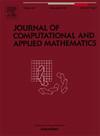FastAGMGar: An aggregation-based algebraic multigrid method
IF 2.1
2区 数学
Q1 MATHEMATICS, APPLIED
Journal of Computational and Applied Mathematics
Pub Date : 2025-01-13
DOI:10.1016/j.cam.2025.116515
引用次数: 0
Abstract
In this paper, we solve large sparse symmetric positive definite linear systems with the Krylov subspace method preconditioned by an aggregation-based algebraic multigrid (AGMG) scheme. We study the AGMGar (stands for AGMG with guaranteed convergence rate) method and present a new method called FastAGMGar. This method is developed by relaxing the aggregation requirement employed in AGMGar. Additionally, an integral correction method is introduced to improve the Jacobi smoother. The applicability of AGMGar and FastAGMGar methods to non-M-matrices is investigated, and their limitations are also examined and mitigated. To improve the performance of solving linear systems with non-M-matrices as coefficient matrices, the original aggregation algorithm is modified by only accepting the aggregate that contains nodes corresponding to negative couplings. Moreover, to reduce the high setup cost of AGMGar caused by the low coarsening ratio, different approaches are considered to compute the coarse-grid matrices based on the coarsening ratio. The numerical results demonstrate the effectiveness of these improvements. Furthermore, compared with classical AGMG and AGMGar, the newly proposed FastAGMGar not only features a shorter setup time but also maintains competitive efficiency in the solution phase. Consequently, this method showcases superior performance, with the shortest total CPU time for all test problems.
求助全文
约1分钟内获得全文
求助全文
来源期刊
CiteScore
5.40
自引率
4.20%
发文量
437
审稿时长
3.0 months
期刊介绍:
The Journal of Computational and Applied Mathematics publishes original papers of high scientific value in all areas of computational and applied mathematics. The main interest of the Journal is in papers that describe and analyze new computational techniques for solving scientific or engineering problems. Also the improved analysis, including the effectiveness and applicability, of existing methods and algorithms is of importance. The computational efficiency (e.g. the convergence, stability, accuracy, ...) should be proved and illustrated by nontrivial numerical examples. Papers describing only variants of existing methods, without adding significant new computational properties are not of interest.
The audience consists of: applied mathematicians, numerical analysts, computational scientists and engineers.

 求助内容:
求助内容: 应助结果提醒方式:
应助结果提醒方式:


